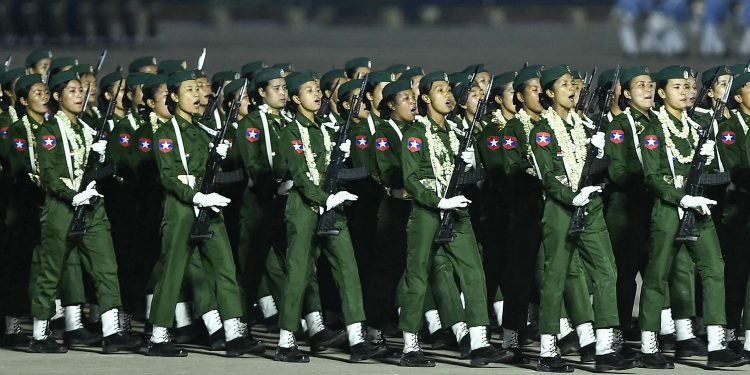With junta forces losing ground across the country, the Myanmar military was forced to scale back its annual parade as it celebrated the 79th Armed Forces Day on Wednesday.
The first three editions of the annual event held under military rule following the 2021 coup were lavish displays of military equipment featuring large numbers of troops, but this year’s parade was scaled down, with mechanized units noticeably absent.
Citing high temperatures due to the El Nino weather phenomenon, the regime held the parade at sunset. It featured an unusually large proportion of female personnel.
Though previous parades included female soldiers, observers said their numbers were higher on Wednesday than at any previous commemoration. The number of male troops was visibly smaller than in previous years, based on a live broadcast of the parade.
This year’s aerial display was also modest compared to last year’s. Apart from a few choppers, the only aircraft taking part were three fighter jets (two Su-30 SMEs and one MiG-29)—a far cry from last year, when the skies were filled with at least 19 aircraft including FTC-2000G, K8W and Yak-130 jets, among others.
The fact that fewer troops took part in this year’s parade, and the large proportion of women, suggests that the military has been seriously depleted by casualties in its daily clashes with resistance forces since a major anti-regime offensive was launched in November last year.

Since then, it has suffered an unprecedented series of defeats on battlefields across Chin, Karenni (Kayah), Rakhine, Kachin and Karen states, losing not only troops, but also piles of weapons, including artillery. Entire battalions have surrendered and hundreds of junta soldiers have fled across the border into neighboring China, Thailand, India and Bangladesh.
Had it not been for a ceasefire agreement brokered by China, the regime might have already lost the whole of northern Shan State.
“The parade could not cover up [the junta’s] defeats in Kachin, Karen and other states, and the fact that it has been weakened,” said a political and military analyst based in Myanmar.
In his address to the event, junta boss Min Aung Hlaing said the national conscription law and reserve force law would boost the country’s defense capabilities and finally enable the regime to “restore peace and stability”.
Min Aung Hlaing paid his respects to retired military officers on Wednesday as part of the Armed Forces Day celebrations. Bowing before ex-president Thein Sein, he explained to the ex-general why he had enforced the conscription law and reserve force law.

Even as his regime forcibly recruits young people into the military, he complained that revolutionary forces were conscripting civilians at the point of a gun.
In stark contrast to the loud promises to crush revolutionary forces that he made in previous years, on Wednesday all he had to say on the topic was: “Terrorist acts must be stopped in time.”
Also on Wednesday, in an apparent effort to salvage his waning popularity within the Myanmar military, Min Aung Hlaing visited the Memorial to the Fallen Heroes in Naypyitaw. With his deputy Soe Win and the navy and air force chiefs he laid a wreath at the memorial—something he did not do during previous Armed Forces Day commemorations.
On the same day, he conferred Thiri Thiha Kyaw and Thiri Thura Kyaw titles—honorary titles he created last week to honor his allies in foreign governments for their contributions to military cooperation with the regime—on 27 Russian military officials. The Russian deputy defense minister attended the Armed Forces Day parade.

















